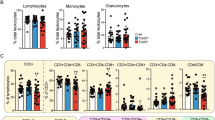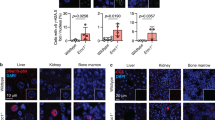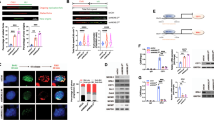Abstract
Mice lacking genes involving in the DNA-damage response (DDR) are often tumor prone owing to genome instability caused by oncogenic challenges. Previous studies demonstrate that activating transcription factor 3 (ATF3), a common stress sensor, can activate the tumor suppressor p53 and regulate expression of p53 target genes upon DNA damage. However, whether ATF3 contributes to the maintenance of genome stability and tumor suppression remains unknown. Here we report that Atf3-deficient (Atf3−/−) mice developed spontaneous tumors, and died significantly earlier than wild-type (Atf3+/+) mice. Consistent with these results, Atf3−/− mouse embryonic fibroblasts (MEFs) had more aberrant chromosomes and micronuclei, and were genetically unstable. Whereas we demonstrated that ATF3 activated p53 and promoted its pro-apoptotic activity in mouse thymi and small intestines, the chromosomal instability caused by Atf3 deficiency was largely dependent on the regulation of p53 by ATF3. Interestingly, loss of Atf3 also promoted spontaneous tumorigenesis in Trp53+/− mice, but did not affect tumor formation in Trp53−/− mice. Our results thus provide the first genetic evidence linking ATF3 to the suppression of the early development of cancer, and underscore the importance of ATF3 in the maintenance of genome integrity.
This is a preview of subscription content, access via your institution
Access options
Subscribe to this journal
Receive 50 print issues and online access
$259.00 per year
only $5.18 per issue
Buy this article
- Purchase on Springer Link
- Instant access to full article PDF
Prices may be subject to local taxes which are calculated during checkout






Similar content being viewed by others
References
Vousden KH, Prives C . Blinded by the light: the growing complexity of p53. Cell 2009; 137: 413–431.
Levine AJ . p53, the cellular gatekeeper for growth and division. Cell 1997; 88: 323–331.
Donehower LA, Harvey M, Slagle BL, McArthur MJ, Montgomery CA, Butel JS et al. Mice deficient for p53 are developmentally normal but susceptible to spontanenous tumors. Nature 1992; 356: 215–221.
Jacks T, Remington L, Williams BO, Schmitt EM, Halachmi S, Bronson RT et al. Tumor spectrum analysis in p53-mutant mice. Curr Biol 1994; 4: 1–7.
Donehower LA, Lozano G . 20 years studying p53 functions in genetically engineered mice. Nat Rev Cancer 2009; 9: 831–841.
Harvey M, Sands AT, Weiss RS, Hegi ME, Wiseman RW, Pantazis P et al. In vitro growth characteristics of embryo fibroblasts isolated from p53-deficient mice. Oncogene 1993; 8: 2457–2467.
Ward IM, Minn K, van Deursen J, Chen J . p53 binding protein 53BP1 is required for DNA damage responses and tumor suppression in mice. Mol Cell Biol 2003; 23: 2556–2563.
Bassing CH, Suh H, Ferguson DO, Chua KF, Manis J, Eckersdorff M et al. Histone H2AX: a dosage-dependent suppressor of oncogenic translocations and tumors. Cell 2003; 114: 359–370.
Morales JC, Franco S, Murphy MM, Bassing CH, Mills KD, Adams MM et al. 53BP1 and p53 synergize to suppress genomic instability and lymphomagenesis. Proc Natl Acad Sci USA 2006; 103: 3310–3315.
Celeste A, Difilippantonio S, Difilippantonio MJ, Fernandez-Capetillo O, Pilch DR, Sedelnikova OA et al. H2AX haploinsufficiency modifies genomic stability and tumor susceptibility. Cell 2003; 114: 371–383.
Hai T, Wolfgang CD, Marsee DK, Allen AE, Sivaprasad U . ATF3 and stress responses. Gene Expr 1999; 7: 321–325.
Yan C, Lu D, Hai T, Boyd DD . Activating transcription factor 3, a stress sensor, activates p53 by blocking its ubiquitination. EMBO J 2005; 24: 2425–2435.
Gilchrist M, Thorsson V, Li B, Rust AG, Korb M, Roach JC et al. Systems biology approaches identify ATF3 as a negative regulator of Toll-like receptor 4. Nature 2006; 441: 173–178.
Fan F, Jin S, Amundson SA, Tong T, Fan W, Zhao H et al. ATF3 induction following DNA damage is regulated by distinct signaling pathways and over-expression of ATF3 protein suppresses cells growth. Oncogene 2002; 21: 7488–7496.
Kool J, Hamdi M, Cornelissen-Steijger P, van der Eb AJ, Terleth C, Van Dam H . Induction of ATF3 by ionizing radiation is mediated via a signaling pathway that includes ATM,Nibrin1,stress-induced MAPkinases and ATF-2. Oncogene 2003; 22: 4235–4242.
Lu D, Wolfgang CD, Hai T . Activating transcription factor 3, a stress-inducible gene, suppresses Ras-stimulated tumorigenesis. J Biol Chem 2006; 281: 10473–10481.
Turchi L, Aberdam E, Mazure N, Pouyssegur J, Deckert M, Kitajima S et al. Hif-2apha mediates UV-induced apoptosis through a novel ATF3-dependent death pathway. Cell Death Differ 2008; 15: 1472–1480.
Cui H, Li X, Wang Q-E, Wang H, Ding H-F, Zhang J et al. The stress responsive gene ATF3 mediates dichotomous UV responses by regulating Tip60 and p53 proteins. J Biol Chem 2016; 291: 10847–10857.
Turchi L, Fareh M, Aberdam E, Kitajima S, Simpson F, Wicking C et al. ATF3 and p15PAF are novel gatekeepers of genomic integrity upon UV stress. Cell Death Differ 2009; 16: 728–737.
Mo P, Wang H, Lu H, Boyd DD, Yan C . MDM2 mediates ubiquitination and degradation of activating transcription factor 3. J Biol Chem 2010; 285: 26908–26915.
Zhao J, Li X, Guo M, Yu J, Yan C . The common stress responsive transcription factor ATF3 binds genomic sites enriched with p300 and H3k27ac for transcriptional regulation. BMC Genomics 2016; 17: 335.
Cui H, Guo M, Xu D, Ding Z-C, Zhou G, Ding H-F et al. The stress-responsive gene ATF3 regulates the histone acetyltransferase Tip60. Nat Commun 2015; 6: 6752.
Yan C, Boyd DD . ATF3 regulates the stability of p53: A link to cancer. Cell Cycle 2006; 5: 926–929.
Jan Y-H, Tsai H-Y, Yang C-J, Huang M-S, Yang Y-F, Lai T-C et al. Adenylate kinase-4 is a marker of poor clinical outcomes that promotes metastasis of lung cancer by downregulating the transcription factor 3. Cancer Res 2012; 72: 5119–5129.
Xie JJ, Xie YM, Chen B, Pan F, Guo JC, Zhao Q et al. ATF3 functions as a novel tumor suppressor with prognostic significance in esophageal squamous cell carcinoma. Oncotarget 2014; 5: 8569–8582.
Wang Z, Kim J, Teng Y, Ding H-F, Zhang J, Hai TYC . Loss of ATF3 promotes hormone-induced prostate carcinogenesis and the emergence of CK5+CK8+ epithelial cells. Oncogene 2016; 35: 3555–3564.
Bartkova J, Hoeji Z, Koed K, Kramer A, Tort F, Zieger K et al. DNA damage response as a candidate anti-cancer barrier in early human tumorigenesis. Nature 2005; 434: 864–870.
Hartman MG, Lu D, Kim ML, Kociba GJ, Shukri T, Buteau J et al. Role for activating transcription factor 3 in stress-induced β-cell apoptosis. Mol Cell Biol 2004; 24: 5721–5732.
Keyes WM, Vogel H, Koster MI, Guo X, Qi Y, Petherbridge KM et al. p63 heterozygous mutant mice are not prone to spontaneous or chemically induced tumors. Proc Natl Acad Sci USA 2006; 103: 8435–8440.
Zhou BS, Elledge SJ . The DNA damage response: putting checkpoints in perspective. Nature 2000; 408: 433–439.
Campbell MR, Wang Y, Andrew SE, Liu Y . Msh2 deficiency leads to chromosomal abnormalities, centrosome amplification, and telomere capping defect. Oncogene 2006; 25: 2531–2536.
Beucher A, Birraux J, Tchouandong L, Barton O, Shibata A, Conrad S et al. ATM and Artemis promote homologous recombination of radiation-induced DNA double-strand breaks in G2. EMBO J 2009; 28: 3413–3427.
Clarke A, Purdie C, Harrison D, Morris R, Bird C, Hooper M et al. Thymocyte apoptosis induced by p53-dependent and independent pathways. Nature 1993; 362: 849–852.
Lowe S, Schmitt E, Smith S, Osborne B, Jacks T . p53 is required for radiation-induced apoptosis in mouse thymocytes. Nature 1993; 362: 847–849.
Merritt AJ, Potten CS, Kemp CJ, Hickman JA, Balmain A, Lane DP et al. The role of p53 in spontaneous and radiation-induced apoptosis in the gastrointestinal tract of normal and p53-deficient mice. Cancer Res 1994; 54: 614–617.
Armata H, Garlick D, Sluss H . The ataxia telangiectasis-mutated target site Ser18 is required for p53-mediated tumor suppression. Cancer Res 2007; 67: 11696–11703.
Gold ES, Ramsey SA, Sartain MJ, Selinummi J, Podolsky I, Rodriguez DJ et al. ATF3 protects against atherosclerosis by suppressing 25-hydroxycholesterol-induced lipid body formation. J Exp Med 2012; 209: 807–817.
Hoetzenecker W, Echtenacher B, Guenova E, Hoetzenecker K, Woelbing F, Bruck J et al. ROS-induced ATF3 causes susceptibility to secondary infections during sepsis-associated immunosuppression. Nat Med 2012; 18: 128–134.
Zhou H, Shen D-F, Bian Z-Y, Zong J, Deng W, Zhang Y et al. Activating transcription factor 3 deficiency promotes cardiac hypertrophy, dysfunction, and fibrosis induced by pressure overload. PLoS ONE 2011; 6: e26744.
Beleza-Meireles A, Tohonen V, Soderhall C, Schwentner C, Radmayr C, Kockum I et al. Activating transcription 3: a hormone responsive gene in the etiology of hypospadias. Eur J Endocrinol 2008; 158: 729–739.
Ishiguro T, Nakajima M, Naito M, Muto T, Tsuruo T . Identification of genes differentially expressed in B16 murine melanoma sublines with different metastatic potentials. Cancer Res 1996; 56: 875–879.
Hackl C, Lang SA, Moser C, Mori A, Fichtner-Feigl S, Hellerbrand C et al. Activating transcription factor-3 (ATF3) functions as a tumor suppressor in colon cancer and is up-regulated upon heat-shock protein 90 (Hsp90) inhibition. BMC Cancer 2010; 10: 668.
Yuan X, Yu L, Li J, Xie G, Rong T, Zhang L et al. ATF3 suppresses metastasis of bladder cancer by regulating gelsolin-mediated remodeling of the actin cytoskeleton. Cancer Res 2013; 73: 3625–3637.
Wang Z, Xu D, Ding H-F, Kim J, Zhang J, Hai T et al. Loss of ATF3 promotes Akt activation and prostate cancer development in a Pten knockout mouse model. Oncogene 2015; 34: 4975–4984.
Wei S, Wang H, Lu C, Malmut S, Zhang J, Ren S et al. The activating transcription factor 3 protein suppresses the oncogenic function of mutant p53 proteins. J Biol Chem 2014; 289: 8947–8959.
Yan C, Jamaluddin M, Aggarwal B, Myers J, Boyd DD . Gene expression profiling identifies activating transcription factor 3 as a novel contributor to the proapoptotic effect of curcumin. Mol Cancer Ther 2005; 4: 233–241.
Bar J, Hasim MS, Baghai T, Niknejad N, Perkins TJ, Stewart DJ et al. Induction of activating transcription factor 3 is associated with Cisplatin responsiveness in non-small cell lung carcinoma cells. Neoplasia 2016; 18: 525–535.
Sooraj D, Xu D, Cain JE, Gold DP, Williams BR . Activating transcription factor 3 expression as a marker of response to the histone deacetylase inhibitor Pracinostat. Mol Cancer Ther 2016; 15: 1726–1739.
Yoo YD, Lee D-H, Cha-Molstad H, Kim H, Mun SR, Ji C et al. Glioma-derived cancer stem cells are hypersensitive to proteasomal inhibition. EMBO Rep 2017; 18: 150–168.
Shin G, Kang TW, Yang S, Baek SJ, Jeong YS, Kim SY . GENT: gene expression database of normal and tumor tissues. Cancer Inform 2011; 10: 149–157.
Zhong S, Fields C, Su N, Pan Y-X, Robertson K . Pharmacologic inhibition of epigenetic modifications, coupled with gene expression profiling, reveals novel targets of aberrant DNA methylation and histone deacetylation in lung cancer. Oncogene 2007; 26: 2621–2634.
Kan Z, Jaiswal BS, Stinson J, Janakiraman V, Bhatt D, Stern HM et al. Diverse somatic mutation patterns and pathway alterations in human cancers. Nature 2010; 466: 869–873.
Chen BPC, Liang G, Whelan J, Hai T . ATF3 and ATF3ΔZip: transcriptional repression versus activation by alternatively spliced isoforms. J Biol Chem 1994; 269: 15819–15826.
Wolford CC, McConoughey SJ, Jalgaonkar SP, Leon M, Merchant AS, Dominick JL et al. Transcription factor ATF3 links host adaptive response to breast cancer metastasis. J Clin Invest 2013; 123: 2893–2906.
Yin X, Dewille JW, Hai T . A potential dichotomous role of ATF3, an adaptive-response gene, in cancer development. Oncogene 2008; 27: 2118–2127.
Wang Z, Yan C . Emerging roles of ATF3 in the suppression of prostate cancer. Mol Cell Oncol 2016; 3: e1010948.
Jiang L, Kon N, Li T, Wang S-J, Su THH, Baer R et al. Ferroptosis as a p53-mediated activity during tumour suppression. Nature 2015; 520: 57–62.
Li T, Kon N, Jiang L, Tan M, Ludwig T, Zhao Y et al. Tumor suppression in the absence of p53-mediated cell-cycle arrest, apoptosis, and senescence. Cell 2012; 149: 1269–1283.
Kim K-H, Jeong J-Y, Surh Y-J, Kim K-W . Expression of stress-response ATF3 is mediated by Nrf2 in astrocytes. Nucleic Acids Res 2010; 38: 48–59.
Jacquet K, Fradet-Turcotte A, Awakumov N, Lambert JP, Roques C, Pandita RK et al. The TIP60 complex regulates bivalent chromatin recognition by 53BP1 through direct H4K20me binding and H2AK15 acetylation. Mol Cell 2016; 62: 409–421.
Gorrini C, Squatrito M, Luise C, Syed N, Perna D, Wark L et al. Tip60 is a haplo-insufficient tumor suppressor required for an oncogene-induced DNA damage response. Nature 2007; 448: 1063–1067.
Zhang C, Gao C, Kawauchi J, Hashimoto Y, Tsuchida N, Kitajima S . Transcriptional activation of the human stress-inducible transcriptional repressor ATF3 gene promoter by p53. Biochem Biophys Res Commun 2002; 297: 1302–1310.
Stelzl U, Worm U, Lalowski M, Haenig C, Brembeck FH, Goehler H et al. A human protein-protein interaction network: a resource for annotating the proteome. Cell 2005; 122: 957–968.
Taketani K, Kawauchi J, Tanaka-Okamoto M, Ishizaki H, Tanaka Y, Sakai T et al. Key role of ATF3 in p53-dependent DR5 induction upon DNA damage of human colon cancer cells. Oncogene 2012; 31: 2210–2221.
Kawauchi J, Zhang C, Nobori K, Hashimoto Y, Adachi MT, Noda A et al. Transcriptional repressor activating transcription factor 3 protects human umbilical vein endothelial cells from tumor necrosis factor-α-induced apoptosis through down-regulation of p53 transcription. J Biol Chem 2002; 277: 39025–39034.
Xu X, Nguyen B-C, Dziunycz P, Chang S, Brooks Y, Lefort K et al. Opposing roles for calcineurin and ATF3 in squamous skin cancer. Nature 2010; 465: 368–372.
Yan C, Wang H, Boyd DD . ATF3 represses 72-kDa type IV collagenase (MMP-2) expression by antagonizing p53-dependent trans-activation of the collagenase promoter. J Biol Chem 2002; 277: 10804–10812.
Boehme KA, Blattner C . Regulation of p53—insights into a complex process. Crit Rev Biochem Mol Biol 2009; 44: 367–392.
Pant V, Lozano G . Limiting the power of p53 through the ubiquitin proteasome pathway. Gene Dev 2014; 28: 1739–1751.
Acknowledgements
This work was supported by the NIH grant R01CA139107 to CY, and the grants from the National Science Foundation of China (81472178) and the State 973 Program of China (2014CB542005) to WD.
Author contributions
ZY, YH and HY bred the mice and carried out histopathological examinations of tumor sections supervised by RK, WD and CY. LL isolated MEFs and prepared slides for cytogenetic analysis. ZY and YH carried out immunohistochemical and immunofluorescence staining with the help of JZ and HD. TH provided the ATF3 −/− mice. BJ, JZ and HD edited the manuscript. CY and WD conceived the study and analyzed the data. CY wrote the manuscript.
Author information
Authors and Affiliations
Corresponding authors
Ethics declarations
Competing interests
The authors declare no conflict of interest.
Additional information
Supplementary Information accompanies this paper on the Oncogene website
Supplementary information
Rights and permissions
About this article
Cite this article
Wang, Z., He, Y., Deng, W. et al. Atf3 deficiency promotes genome instability and spontaneous tumorigenesis in mice. Oncogene 37, 18–27 (2018). https://doi.org/10.1038/onc.2017.310
Received:
Revised:
Accepted:
Published:
Issue Date:
DOI: https://doi.org/10.1038/onc.2017.310
This article is cited by
-
Age-Associated Different Transcriptome Profiling in Zebrafish and Rats: an Insight into the Diversity of Vertebrate Aging
Marine Biotechnology (2022)
-
Decreased expression of ATF3, orchestrated by β-catenin/TCF3, miR-17-5p and HOXA11-AS, promoted gastric cancer progression via increased β-catenin and CEMIP
Experimental & Molecular Medicine (2021)
-
ATF-3 expression inhibits melanoma growth by downregulating ERK and AKT pathways
Laboratory Investigation (2021)
-
Competitive ubiquitination activates the tumor suppressor p53
Cell Death & Differentiation (2020)
-
ATF3 promotes erastin-induced ferroptosis by suppressing system Xc–
Cell Death & Differentiation (2020)



